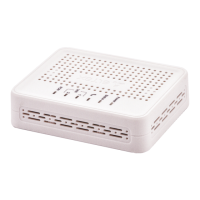____________________________________________________________________________________
____________________________________________________________________________________
NTU Optical Network Terminals 29
3.3 NTU-RG-1402G-W Architecture
Fig. 18— Logical Architecture of a Device with Factory Settings
Main Components of the Device:
– optical receiver/transmitter (SFF module) for conversion of an optical signal into an electric one;
– processor (PON chip) which converts Ethernet and GPON interfaces.
– Wi-Fi module is intended to organize wireless interface on the device.
A device with factory (initial) settings have the following logical blocks (see Fig.18Fig. 18):
Br1;
Voice (VoIP block);
eth0…3;
FXS0…1;
wl0;
IPInterface.
In this case, the br1 block is used to combine LAN ports in one group.
The eth0..3 blocks physically represent Ethernet ports with RJ-45 connector for connection of PC, STB, or
other network devices. They are logically included into the br1 block.
FXS0..1 blocks are ports with RJ-11 connectors for connection of analogue phones. They are logically
included into the Voice block. The Voice block can be controlled through web interface or remotely with ACS
server through TR-069 protocol. The block specifies VoIP service parameters (SIP server address, phone
numbers, VAS, etc.)
The wl0 block is an interface for Wi-Fi module connection.
The Filter and Marking blocks are designed to include local interfaces in one group (br1). These blocks are
responsible for traffic rules: Filter is used for incoming traffic, while Marking—for the outgoing one.

